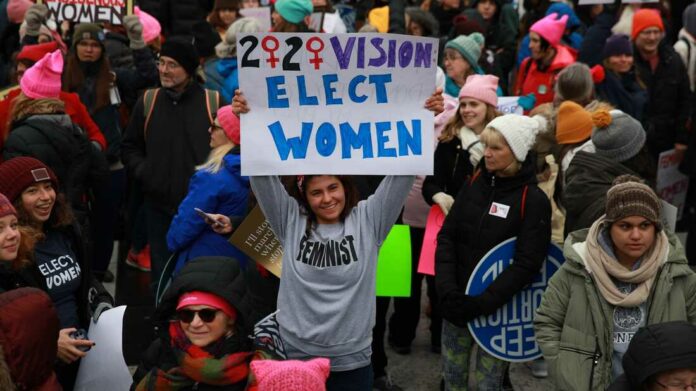In the aftermath of Donald Trump’s election victory in November 2016, a palpable sense of disquiet pervaded the feminist community. Beneath the buoyant rhetoric of American exceptionalism lurked profound fears regarding the sociopolitical landscape. This article endeavors to unpack the myriad reasons why feminists were upset over Trump’s ascension, decoding the backlash that ensued in feminist circles.
The catalyst for these feelings can largely be traced to Trump’s contentious rhetoric and policies regarding women and marginalized communities. The unexpected triumph of a candidate who had openly expressed derogatory sentiments toward women—a sentiment encapsulated in his infamous “grab them by the pussy” remark—was perceived as a regressive step in the long march toward gender equality. This shock was further amplified by Trump’s assemblage of an administration replete with individuals who had historically demonstrated hostility towards women’s rights.
Understanding this complex emotional and political response requires a thorough examination of the ramifications that Trump’s presidency portended for women’s rights and social equity.
The Numerical Paradigm: Women’s Rights in the Balance
One of the immediate concerns that surged among feminists was the fragility of the rights institutions that had been painstakingly built over decades. The Women’s March, which saw millions of participants rallying in dissent in January 2017, epitomized this collective anxiety. In a landscape where gains in reproductive rights, equal pay, and anti-harassment measures faced the prospect of erosion, the need for mobilization became imperative.
During Trump’s tenure, the administration’s policy shifts included attempts to defund organizations such as Planned Parenthood, a crucial provider of reproductive health services. Furthermore, the administration’s stance on issues such as the Affordable Care Act raised alarms about healthcare access and insurance coverage for contraception. Thus, the numerical representation of women in political decision-making positions declined under Trump, signaling a dismal reality for the pursuit of equitable representation.
It became increasingly evident that executive orders, legislative actions, and judicial appointments could chip away at the legal framework enveloping women’s rights, potentially setting a precedent for regression. As this landscape shifted, many feminists rallied not only for advocacy but for the preservation of the hard-won rights of women.
Reinforcement of Patriarchal Norms: The Cultural Backlash
At the crux of feminist dissent was the recognition that Trump’s election signified a cultural backlash against feminist progress. The tenor of the discourse shifted, emboldening a demographic that felt threatened by evolving gender norms and increased visibility for women’s issues. Many feminist analysts argued that Trump’s rise to power was indicative of deep-seated misogyny resurfacing, underpinned by a yearning for a return to a more patriarchal societal structure.
By amplifying anti-feminist sentiments, Trump’s administration paradoxically catalyzed broader conversations about women’s rights. While his rhetoric galvanized action among feminists, it simultaneously deepened divisions between differing ideological factions within the feminist movement. In particular, issues relating to intersectionality—the recognition that women experience oppression in varying configurations—profoundly affected how various groups interpreted Trump’s policies.
This concept of intersectionality underscores the fact that Trump’s policies disproportionately impacted women of color, LGBTQ+ individuals, and economically marginalized women. Thus, the backlash was not merely a reaction to Trump’s presidency but an intricate dance around the multifaceted challenges women face within a patriarchal structure.
Reinvigorated Activism: The Feminist Reawakening
The wave of indignation that followed Trump’s election acted as a catalyst for renewed feminist activism. Various aspects of the feminist movement witnessed a reinvigoration, marked by vibrant protests, grassroots organizing, and the mobilization of women across diverse backgrounds. This reawakening articulated not only a rejection of Trump’s policies but an ongoing commitment to advocate for issues long sidelined in political discourse.
Grassroots organizations began to flourish, and coalitions were forged to address a range of issues from sexual harassment to reproductive rights. In witnessing the erosion of hard-fought gains, feminists galvanized a broad spectrum of support, often leveraging social media to disseminate information and build communities of resistance. This digital mobilization elevated awareness of issues such as the #MeToo movement, which exposed pervasive sexual harassment and violence, an issue that resonated deeply with many in the feminist community.
As the feminist agenda expanded in response to unprecedented challenges, discussions on inclusivity grew prominent. The varied experiences and needs of women from different races, sexual orientations, and socio-economic backgrounds were brought to the fore. Activists pushed for a radical rethinking of the feminist agenda, seeking to ensure that it resonated universally, rather than adhering to a myopic interpretation of women’s rights.
The Triumph of Community and Solidarity: The Road Ahead
While the frustration stemming from Trump’s presidency cannot be understated, it also ignited significant conversations about resilience and collective action among feminists. This newfound sense of urgency has bred hope and solidarity in the feminist community. Still, the path forward remains fraught with challenges.
Moving forward, feminists must navigate the intricate web of policy, culture, and coalition-building in order to safeguard and expand upon their rights. Lineages of activism from different movements must merge to forge a cohesive front against an administration perceived as antagonistic towards progressive values. Innovative models of advocacy and an intersectional worldview are imperative if feminists seek to create substantial and lasting change.
Moreover, it is essential to continue examining the socio-political terrain through an academic lens, scrutinizing legislative processes, public sentiment, and grassroots initiatives. In doing so, feminists can not only elucidate the imperatives of current struggles but also forge a pathway towards future victories in gender and social justice.
In conclusion, the backlash from feminists regarding Trump’s election victory encapsulates a broader struggle against regression and a charge towards reclaiming agency. It is a narrative woven with complexity, resilience, and the unyielding belief in equality. As feminist movements adapt and coalesce amid changing political climates, they must remain vigilant in the face of challenges, advocating for a world where gender equity is not merely a dream but a tangible reality.





























